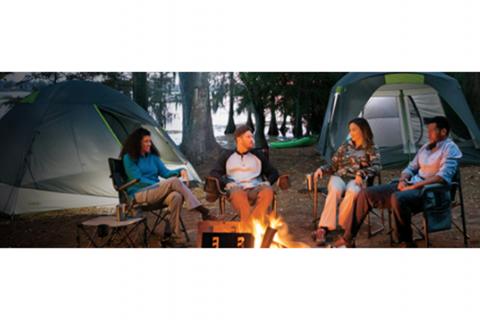
Stop waiting for the perfect forecast to go camping. Get out there now with these six essentials for your springtime adventures.
Sure summertime is the classic time to go camping, but don't forget about the other three seasons. Each one presents its own unique experience, and challenges. Take spring for example. Sure the weather changes on a whim, but April, May and June are also the best months to watch Mother Nature's wonders as they wake up. Dogwoods are blooming, turkeys gobbling and the crappie are there in the shallows waiting to be caught. So don't be a fair-weather fan of the outdoors. Instead, prepare yourself properly with the right gear for your spring campout.
First, a good, weather-proof shelter - one that can defend against wind and rain - is probably the most important part of a spring camping set-up. In their shape and construction materials, geodesic tents are designed to stand strong in high winds. Cabela's West Wind Dome Tent has five fiberglass poles and additional tie-out points that maintain the tent's structural integrity in the wind, and the full-coverage fly prevents wind-driven rain from reaching the inside of the tent. This keeps you and your family dry and protected. It also has a large vestibule, providing an area outside the sleeping area to cook meals or store gear in inclement weather.
Because spring storms can happen without notice, you may need to get your tent up quickly. Consider a quick-pitch tent such as the Coleman Legacy Fast-Pitch Dome Tent. Like the West Wind it features a dome construction, but adds the benefit of pre-attached poles and quick-set feet with help get the tent up and full-coverage fly in place faster. Weather-Tec system includes fully sealed seams, tub-style floor and polyester walls and special, weather-guard zippers to seal out water.
While a good tent will keep spring-time campers dry, there are still meals to consider. A well-pitched tarp or pop-up canopy can provided a protected space to cook and relax outside the tent, but I like special-purpose shelters such at the Cabela's Quick-Set Screen Shelter. While primarily designed as a sunshade, the shelter has polyester walls with taped seams for more-than-adequate resistance to light rain and leaks.
Another kitchen consideration any time of year is keeping everything in place. A well-organized cooking area not only makes creating a delicious camp meal easier, it lowers the stress level of the cook, which is why we are in the outdoors anyway. I love the way the Camp Chef Sherpa Camp Organizer serves double-duty as a portable kitchen-cabinet system and handy countertop. The designers thought of everything, including the kitchen sink in the form of a nylon bag that is lined to hold water.
One of the primary benefits of car camping is not sacrificing comfort for weight. That means ditching the cocoon-like mummy bag for a roomy, luxurious three-season sleeping bag like those in Cabela's Mountain Trapper series. Instead of a slick nylon lining, they sub in soft, warm cotton flannel that is, in my opinion, more comfortable than the sheets at home. Outside, a canvas shell wears well and, along with the warm polyfil insulation, helps keep cooler, spring nights at bay.
Getting off the ground will also help keep you warm at night, so consider adding a cot to your spring kit. Conventional models might be a little tall for standard dome tents, but lower models like the Therm-A-Rest Luxurylite Cots cradle campers far enough from the floor to keep cold from seeping in. It also packs down into a small, lightweight stuff bag, making it easy to pack along on any adventure. In cooler weather, you can also top the cot with a quality sleeping pad like Cabela's Instinct model, which is insulated with Primaloft Infinity fibers for even greater warmth and comfort.
- 2144 views

